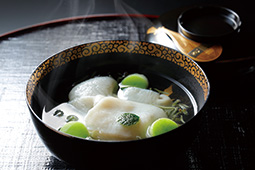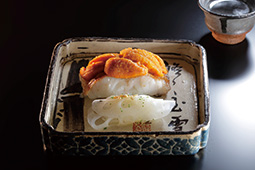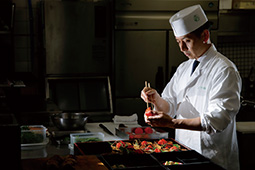INDEX
- English
- 日本語

Black-lacquered bento box, one of the wide variety of dishware used at Kinobu to complement the food, the seasons and the occasion. - English
- 日本語

Glassware, one of the wide variety of dishware



Some of the wide variety of dishware used at Kinobu to complement the food, the seasons and the occasion. From top: porcelain, decorated lacquerware, pottery 
Takahashi Takuji, third-generation owner of Kyo-ryori Kinobu
January 2021
Kyoto Cuisine: Showing Hospitality with Dishware

Chefs of Kyoto cuisine take pride in its tradition and prestige, choosing their dishware according to the menu and their guests, while guests appreciate the cuisine and dishware as a seamless work of art and enjoy the meal.

Among the Japanese cuisines, Kyoto cuisine*, cultivated in Japan’s ancient capital and cultural center of Kyoto, places a particularly high importance on a welcoming spirit of hospitality. A key element of this is dishware, exquisitely arranged to make the most of the original colors and delicate textures of the seasonal ingredients, imparting a sense of seasonality that appeals to the feelings of the guests. Chefs of Kyoto cuisine select their dishware with this in mind.
Takahashi Takuji, the third-generation owner of Kyoto’s long-established Japanese restaurant Kinobu and who appears on NHK (Japan Broadcasting Corporation)’s TV cooking program “Kyo no Ryori (Today’s Cooking),” says, “First, I devise a menu to suit the guests. Then I choose the dishware. I choose the dishware as carefully as I choose the menu, because kaiseki cuisine is a multi-course meal where dishes are served one at a time, using a different type of dishware for each one. Japan has a wide variety of dishware, including porcelain, ceramics such as Bizen-yaki and Shino-yaki, and lacquerware. I choose dishware that complements the dishes and is seasonally appropriate, as well as taking into consideration the purpose of the guests’ visit and their frame of mind.”



Each item of dishware has a background story connected with the time and place that it was made as well as being imbued with the thoughts of the artist. The chef chooses the ingredients and dishware, and considers the arrangement of the meal, with an understanding of the story behind the dishware and of the guests on that particular day. For their part, the guests first admire the arrangement of the dish before enjoying the food, appreciating the dishware again as they savor the aftertaste of the meal.
“Western cuisine uses knives and forks and Chinese cuisine uses ivory chopsticks, so porcelain plates and other sturdy dishes became the mainstream to prevent the dishware from getting scratched. Japanese cuisine, however, uses chopsticks made of wood, a soft material, so a wide variety of dishware can be used. As well as hard ceramics, unglazed dishware and delicate lacquerware came to be widely used and an extensive range of dishware emerged that is rarely seen elsewhere in the world,” explains Takahashi.

Unlike French or other Western cuisine, which may be said to showcase the personality of the chef, in Kyoto cuisine the chef takes a backstage role. Likewise, the choice of dishware should be unassuming rather than ostentatious. At the same time, “Using a wide variety of dishware helps to express the long history and depth of Japanese cuisine in an unobtrusive way,” says Takahashi.
It is interesting to consider how many pieces of dishware Kinobu owns. The restaurant’s three storehouses hold some tens of thousands of pieces in total, with the number continuing to grow. The restaurant has even added Western dishware such as Meissen to cater to overseas guests. Takahashi has compiled a list of all the dishware owned by the restaurant, from which he chooses the pieces that best suit each dish and each guest.
The number of pieces of dishware aside, the depth of the hospitality shown to each and every valued guest by Kyoto chefs is impressive. If you have a chance to visit Kyoto, the ancient capital of Japan, I recommend that you experience Kyoto cuisine along with the dishware.
* Cuisine created using cooking methods backed by traditional techniques based on “dashi” (soup stock), synthesizing the five systems of Japanese cuisine formed over the history of Kyoto (daikyo ryori, shojin ryori, honzen ryori, kaiseki ryori, obanzai)
https://www.kouiki-kansai.jp/koikirengo/jisijimu/nosui/kansainosyoku/870.html

